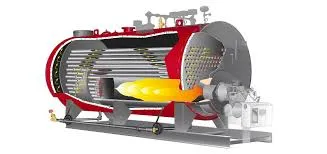
Feb . 04, 2025 03:29 Back to list
biomass fired steam boiler
The integration of safety valves in steam boilers is pivotal for ensuring the secure and efficient operation of these essential industrial devices. Safety valves play a critical role in protecting the boiler from overpressure situations, thereby preventing potential hazards such as explosions or leaks. Drawing from years of comprehensive experience as a seasoned professional in the boiler systems domain, this article delves into the essentials of steam boiler safety valves and their importance, while addressing the key elements that establish their relevance in modern industrial applications.
Professional expertise provides insight into selecting the right materials and design configurations for safety valves, which varies based on specific industrial requirements. High-quality alloys and corrosion-resistant materials are preferred to extend valve lifespan and enhance safety under challenging operational environments. Additionally, modern valves incorporate advanced design features that allow for smoother operation and greater precision in pressure control. Authority in Regulatory and Safety Standards Acquiring knowledge about the relevant safety standards and regulations is a testament to one’s authoritative stance in the industry. Various national and international standards, such as ASME (American Society of Mechanical Engineers) guidelines, dictate the design, manufacturing, and installation criteria for safety valves. Compliance with these benchmarks not only underscores the credibility of the valve's efficacy but also ensures adherence to legal safety requirements. Establishing Trust through Verified Reliability The trustworthiness of steam boiler safety valves is non-negotiable. It stems from proven reliability records and successful operational histories in diverse industrial settings. Valves from reputed manufacturers undergo stringent quality checks and are backed by certifications that vouch for their safety and efficiency. Conclusion The strategic role of safety valves in steam boilers cannot be overstated. Their design and operational integrity embody the fine balance between technological acumen and industrial safety. By leveraging a deep pool of experience, expertise, authority, and trust, industries can confidently rely on safety valves to protect both human and infrastructural assets. The careful consideration of design, material, and regular maintenance practices is fundamental to optimizing safety valve performance, ensuring they meet both operational demands and safety standards effectively.


Professional expertise provides insight into selecting the right materials and design configurations for safety valves, which varies based on specific industrial requirements. High-quality alloys and corrosion-resistant materials are preferred to extend valve lifespan and enhance safety under challenging operational environments. Additionally, modern valves incorporate advanced design features that allow for smoother operation and greater precision in pressure control. Authority in Regulatory and Safety Standards Acquiring knowledge about the relevant safety standards and regulations is a testament to one’s authoritative stance in the industry. Various national and international standards, such as ASME (American Society of Mechanical Engineers) guidelines, dictate the design, manufacturing, and installation criteria for safety valves. Compliance with these benchmarks not only underscores the credibility of the valve's efficacy but also ensures adherence to legal safety requirements. Establishing Trust through Verified Reliability The trustworthiness of steam boiler safety valves is non-negotiable. It stems from proven reliability records and successful operational histories in diverse industrial settings. Valves from reputed manufacturers undergo stringent quality checks and are backed by certifications that vouch for their safety and efficiency. Conclusion The strategic role of safety valves in steam boilers cannot be overstated. Their design and operational integrity embody the fine balance between technological acumen and industrial safety. By leveraging a deep pool of experience, expertise, authority, and trust, industries can confidently rely on safety valves to protect both human and infrastructural assets. The careful consideration of design, material, and regular maintenance practices is fundamental to optimizing safety valve performance, ensuring they meet both operational demands and safety standards effectively.
Share
Latest News
-
High-Efficiency Commercial Oil Fired Steam Boiler for Industry
NewsJul.30,2025
-
High-Efficiency Biomass Fired Thermal Oil Boiler Solutions
NewsJul.30,2025
-
High Efficiency Gas Fired Thermal Oil Boiler for Industrial Heating
NewsJul.29,2025
-
High-Efficiency Gas Fired Hot Water Boiler for Sale – Reliable & Affordable
NewsJul.29,2025
-
High Efficiency Biomass Fired Hot Water Boiler for Industrial and Commercial Use
NewsJul.29,2025
-
High-Efficiency Biomass Fired Hot Water Boiler for Industrial Use
NewsJul.28,2025
Related PRODUCTS
Copyright © 2025 HEBEI HONGZE BOILER MANUFACTURING CO., LTD. All Rights Reserved. Sitemap | Privacy Policy






















